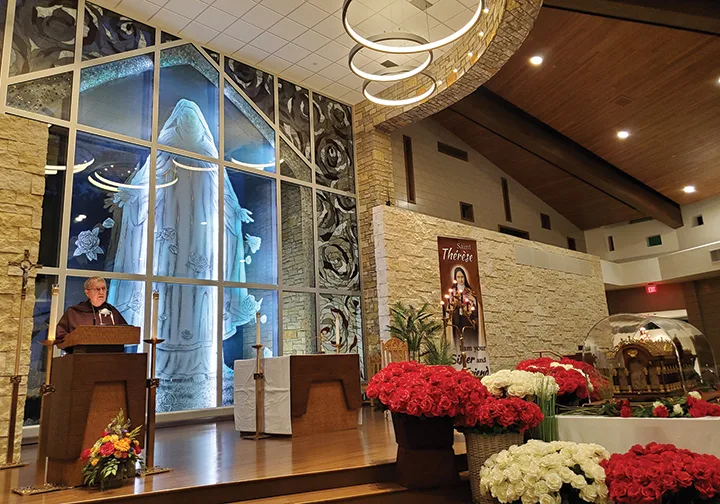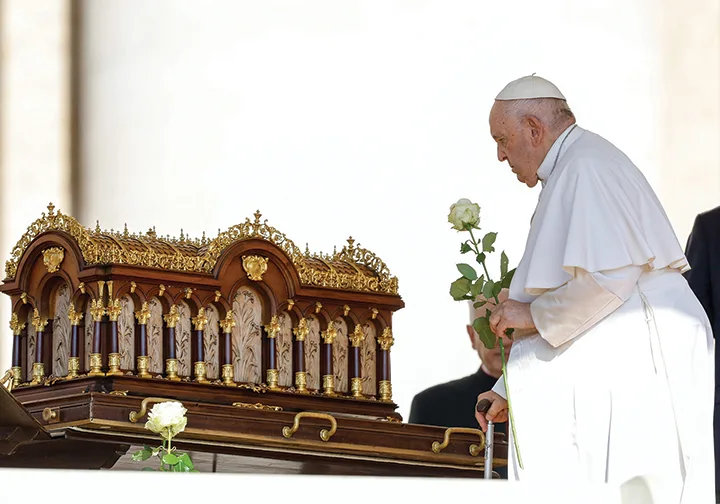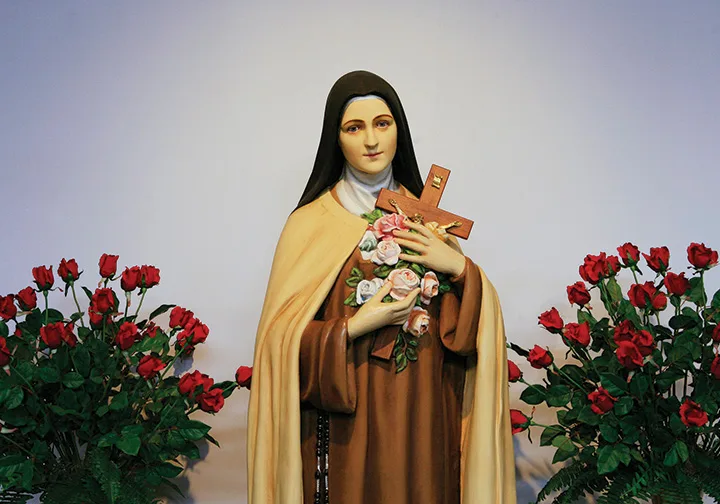
by Marc and Julie Anderson
mjanderson@theleaven.org
DARIEN, ILLINOIS — For months, Father Tom Schrader, OCarm, who is in his fifth year as director of the Society of the Little Flower, has been anticipating the release of a papal document about St. Thérèse. Now that it’s been published, the priest is exploring its richness and hopes others will, too.
Founded in 1923 with a current membership of around 300,000, the mission of the Society of the Little Flower (the world’s largest organization dedicated to St. Thérèse) is to promote devotion to the saint and to “enable Carmelites throughout the world to make a difference in people’s lives through Gospel ministries and the education of seminarians, fulfilling her mission to ‘make God known and loved to the ends of the earth’ in the most concrete ways of charity and justice.”
Published on Oct. 15, the apostolic exhortation “C’est la confiance,” or “On Confidence in the Merciful Love of God,” was written by Pope Francis for the 150th anniversary of the birth of St. Thérèse. Exploring its depth, Father Tom said, will take time. Still, he’s already found several compelling passages.
Paragraph 6: “The church quickly recognized her great significance and the distinctiveness of her evangelical spirituality.”
The saint’s relationship with the popes is significant, said Father Tom. Pope Francis begins with St. Thérèse’s now famous audience with Pope Leo XIII in which she begged for permission to enter Carmel a year earlier than the rule allowed.
“You can’t forget that she was referred to as ‘the greatest saint of modern times,’ [by Pope Pius X],” Father Tom said. “And for me, I think there’s something really [significant] to that in terms of the childlike innocence she brings to her relationship with Jesus and her ability to impress great minds.
“I don’t think we realize how the intellectual life, especially in Europe, was really affecting the church and how it responded to people in terms of faith, and I still think we’re seeing the ravages of that, that kind of modernism.”

Perhaps a lesser-known aspect of St. Thérèse’s spirituality, Father Tom said, can be found in paragraphs 25-27, under the heading, “Fire burning in the night.”
On April 3, 1896, Thérèse experienced hemoptysis, the first symptom of tuberculosis. From that night to the end of her life, she suffered tremendously physically, but also spiritually.
“That’s a big part of her,” Father Tom said, but not an aspect he usually addresses when speaking about her.
“I don’t think people really understand it,” he said. “Unless you’ve experienced a dark night, I don’t think it’s something you really can say, ‘Oh, this is what that means.’”
But its importance to her life is inescapable.
“[The dark night] really was the crucible for St. Thérèse. It’s where she comes to so many realizations, including what’s she going to be . . . the shower of roses . . . ‘Everything is grace.’ It all comes out of that, but I think it comes out of her actual experience of suffering.”
Paragraph 25: “Thérèse experienced faith most powerfully and surely in the midst of the dark night and especially amid the darkness of Calvary.”
And later: “In union with Jesus, who took upon himself all the darkness of the sin of the world when he willed to drink from the cup of the Passion, Thérèse came to appreciate its underlying sense of despair and sheer emptiness.”

Father Tom said he found this entire section by Pope Francis extremely powerful, given some of his own life experiences.
“You can’t understand Thérèse without understanding that,” he said. “I think that when you say ‘the dark night,’ it’s a little bit scary. And I think unless you have a developed prayer life, you can’t really talk about it.
“Someone can’t have a dark night without having a really deep prayer life and a really deep relationship with the Lord.”
Thérèse only came to appreciate the paschal mystery through her own suffering, he said, and paragraph 25 really underscores that fact.
Paragraph 27: “Even in her darkness, she experienced the complete trust of a child that finds refuge, unafraid, in the embrace of its father and mother. . . . This is one of the loftiest insights of Thérèse, one of her major contributions to the entire People of God. In an extraordinary way, she probed the depths of divine mercy, and drew from them the light of her limitless hope.”
One of the most surprising elements of the Holy Father’s words on St. Thérèse, said Father Tom, was his focus on the saint’s desire to save souls and her missionary zeal.
“You don’t necessarily think of this very intentionality of saving souls,” he said, “but on the other hand, [Pope Francis] really frames this within the whole heart of mission, and he loves to refer to the church as a missionary church.
“I think that in so many ways he’s seeing Thérèse as a contemporary evangelist that’s bringing the message of Jesus’ love. . . . Even in paragraph 10, [the pope] writes [that St. Thérèse said] ‘Lord, you know it, I have no other treasures than the souls it has pleased you to unite to mine.’”
“It really struck me first of all why she is the patroness of missions, but also why Pope Francis is taking the time to really lift her up,” Father Tom said.
Finally, Father Tom noted he was also surprised by the attention paid to the shower of roses promised by St. Thérèse.
“It’s such a wonderful way that she shows she’s listening and interceding,” he said. “That’s probably the most surprising thing about the document — how that’s not brushed away but is seen as something that’s real and a part of real people’s experiences.”
To read Pope Francis’ apostolic exhortation “On Confidence in the Merciful Love of God” in its entirety, click here.
Who was St. Thérèse?
In her autobiography, “Story of a Soul,” St. Thérèse (1873-1897) explained her belief that she was a little soul, not capable of extraordinary accomplishments. Instead, she promoted what has become known as the Little Way. It refers to having a complete childlike trust in God and doing all things, no matter how small, for love.
On July 17, 1897, St. Thérèse said, “I feel that my mission is about to begin, my mission of making others love God as I love him, my mission of teaching my little way to souls.”
Dying at age 24 on Sept. 30, 1897, she was beatified in 1923 and canonized in 1925. Two years later, St. Thérèse was declared patroness of the missions. In 1997, St. Pope John Paul II named her a Doctor of the Church.






